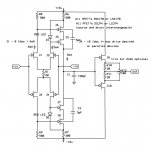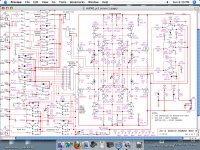There is NO ONE SPECIFIC CONFIGURATION that is best for this topology it depends on what it is designed to do.
Back OT, just wanted to show that this arrangement could even behave like an 8 legs. Very high open-loop gain, very low open loop bandwidth, and lots of feedback.
Well of course, Scott. I, too, started with the IC op amp, then I switched to the discrete TA, then added a discrete op amp, etc. I have personally found that less feedback is better than more feedback, unless it is for test instrumentation. THEN, I have even gone so far as to use 2 pole compensation for MAXIMUM FEEDBACK at higher frequencies.
Are the walls rigidly mounted, or is there a compliance/weight element?
Rigid if you are asking me.
John, wouldn`t be better for mosfet drivers to work in class A?Here is the Parasound JC-1 output stage:
Yes bass! Before I tell you how, think about it.
Why would I wish to know how? You already said it didn't work.
btw, it doesn't work unless every wall has the acoustic impedance of free air. With long wavelengths, if the absorber spike angle is too wide, back pressure builds up before the multiple reflections can fully absorb.
jn
One last one
for now, the resistors collapse to a single 20 Ohm and the noise is better. The higher gm needs a couple of small comp caps but this one looks to be stable down to gain of 2 (sims of course). Aol is 126dB and 70dB at 20kHz just like you know who. See JC's circuits are all we ever needed if only IC's had two flavors of FET's.
for now, the resistors collapse to a single 20 Ohm and the noise is better. The higher gm needs a couple of small comp caps but this one looks to be stable down to gain of 2 (sims of course). Aol is 126dB and 70dB at 20kHz just like you know who. See JC's circuits are all we ever needed if only IC's had two flavors of FET's.
Attachments
Last edited:
for now, the resistors collapse to a single 20 Ohm and the noise is better. The higher gm needs a couple of small comp caps but this one looks to be stable down to gain of 2 (sims of course). Aol is 126dB and 70dB at 20kHz just like you know who. See JC's circuits are all we ever needed if only IC's had two flavors of FET's.
Looks good Scott. I have built this before and the values were within a few Ohms of what you have also ran it with the followers outside of the loop.
To 'prove' that 60dB or so is really all you need, try a conventional track, immediately followed by the same, but attenuated by 60dB, as the following track. The latter will then also be "head up to the speaker" material.I have at least one totally (I think) uncompressed 44.1/16 CD that I find unlistenable under normal (even fairly quiet) conditions. To tolerate the loud parts the quiet parts require you to put your head up to the speaker. Or listen like they do at audiophile shows and drive everyone else away.
I have at least one totally (I think) uncompressed 44.1/16 CD that I find unlistenable under normal (even fairly quiet) conditions. To tolerate the loud parts the quiet parts require you to put your head up to the speaker. Or listen like they do at audiophile shows and drive everyone else away.
Your system is suffering from dynamic compression , bigger and better speakers with 1kw drive will solve this ..
Now we will discuss LEVEL 2! [AKA Worf '-) ]
Are you going to discuss your electronic xover ...?
<nonsense on>Your system is suffering from dynamic compression , bigger and better speakers with 1kw drive will solve this ..

It was commented that
If a live, acoustic ensemble was playing in a room at the show, at those levels, would it likewise drive the 'audiophiles' away ...Or listen like they do at audiophile shows and drive everyone else away.
<nonsense off> ...
Now we will discuss LEVEL 2! [AKA Worf '-) ]
No one Folded cascode ! I always think of you as "Folded Cascode Man".
Why would I wish to know how? You already said it didn't work.
btw, it doesn't work unless every wall has the acoustic impedance of free air. With long wavelengths, if the absorber spike angle is too wide, back pressure builds up before the multiple reflections can fully absorb.
jn
I said it didn't work but I just might know how to fix it. Come on, you know the issues, can you come up with a method? I can think of three approaches. One is cool enough to be almost cheating.
For the bass? I guess you could suck it out through the walls, by basically making the walls out of speakers, with a mic and amp for each speaker. It would be sort-of like a "noise-cancelling" system, but bigger than most.
With the right inner wall material, and an array of bare linear motors attached to it, you could probably make the whole wall into an adaptive cancelling system.
Maybe it could even be done with a planar magnetic type of driver for the inner wall surface, but one having many short segments of conductors, each separately energized, with some array of microphones on the inside, but a centralized controller figuring out what current each short conductor segment should get (and making it so). Or maybe don't centralize the controller and have a mic and basically just a couple of FETs (or a small chipamp) for each segment.
You could probably get it almost to the point where you didn't need any absorbers at all.
(Maybe I should start a company to make and sell active sound-canceling panels.
With the right inner wall material, and an array of bare linear motors attached to it, you could probably make the whole wall into an adaptive cancelling system.
Maybe it could even be done with a planar magnetic type of driver for the inner wall surface, but one having many short segments of conductors, each separately energized, with some array of microphones on the inside, but a centralized controller figuring out what current each short conductor segment should get (and making it so). Or maybe don't centralize the controller and have a mic and basically just a couple of FETs (or a small chipamp) for each segment.
You could probably get it almost to the point where you didn't need any absorbers at all.
(Maybe I should start a company to make and sell active sound-canceling panels.
Last edited:
- Status
- Not open for further replies.
- Home
- Member Areas
- The Lounge
- John Curl's Blowtorch preamplifier part II

